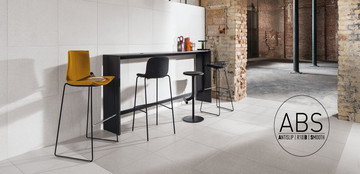RAKO ADVISE
When choosing glazed tiling it is necessary to pay attention to the declared degrese of surface abrasive wear rating PEI and always respekt the producer´s recommendation in the Technical catalogue.
The floor design should be a part of a project documentation for the construction, it has to set the conditions for a good functionality within its anticipated lifetime, the composition of the floor construction, i.e. particular layers, their thickness, quality or even the composition of the layers and the working procedure for thein construction, positioning of the expansion and contraction joints in the floor or in its layers and their finish.
RAKO RECOMMENDATION
Anti-skid tiles R10 to R13 are concentrated in the TAURUS series and the are primarily designed for safe floors in public objels, house halls, entrance and cellar space, exteriors etc.
Vitrified ceramic tile elements of the TAURUS and KENTAUR segments (catalogue No. T……. ,D…….) have very good frost resistence and are particularly designed for horizontal frost-resistant floor tiling, e.g. for balconies and terraces. Selected types have the highest abrasion resistence. Non-glazed TAURUS programme products with declarated anti-slip are therefore suitable even for floors with high pedestrián traffic, e.g. common areas in the houses, entrances, stairways, balconies etc. Highly vitrified glazed tiles KENTAUR have universal use as floor as well as wall tiling of interiors and exterior surfaces exposed to weather conditions, high mechanical strain and polution. For this mason, these tiles are highly suitable for the use in apartments, houses and in exterior on terraces and balconies.
SILENT TILES
Can you her every single step of your neighbours above? Be it in a block of flats or in a family house, you will start being interested in the term „step soundproofing“. It is really possible, that there is a ceramic floor tiling upstairs without an appropriate acoustic insulation. There is still no need to get rid of otherwise practical ceramic tiling. There is a sound insulating panel – SDI panel.



Tips:
When set under the tiling, the sound insulating panel – SDI panel muffles the noise level by 16 – 18 decibel. The thickness of this material is only 4,8 mm and it is laid between the glue layers when tiling the traditional way. You will save money on ceiling constructions and your floor will couly with effective standards. Your neighbours will not hear anything … hopping children, falling heavy objects etc.
STAIRS
For stair tiling in interiors and exteriors, we suggest using floor tile. For apartments, family houses and exklusive interiors, step tiles 30 x 60 cm from the series Clay, Geo, Pietra, Rock, SandstonePlus,Unistone are suitable. For standard stairways in blocks of flats or family houses, public buildings, offices, schools and salesrooms, it is possible to use step tiles 30 x 30 cm of the series TAURUS, Travertin etc. In exteriors in front of blocks of flats, offices and schools, it is necessary to use step tiles Taurus Granit 30 x 30 cm with a relief surface SR7 or SRM and a sufficient slip resistence R11/B.


BALCONY
The underlay must be made of frost-resistant rounded material without additional deformations, with pure smooth surface without dirt. The underlay surfaces must have an inuline of min. 2%. The construction of the handrailing must be anchored outsider the ceramic surface.


The hydroinsulating layer is spread in two layers onto a penetrated and sloped underlay using a liquid hydroinsulation substance (e.g. SE 6). The hydroinsulation layer must be reliably waterproof connected to the drain and be lead to the min. height of 15 cm onto the adjoining vertical surface and walls using a flexible sealing tape. Onto this high quality hydroinsulation layer, it is possible to lay sintered ceramic floor tiles TAURUS and KENTAUR, the best option is Taurus Granit, Travertin with balcony tiles into a flexible frost resistant adhesive C2TE S1 (e.g. AD 530). The gluing is done by combined layering of the glueing substance onto the underlay and the tile as well (Buttering-Floating) with removal of air bubbles in the adhesive, see Pic. 2, that prevents the cumulation of water under the tiling. A more suitable solution offers flowing glues type C1FE (e.g. AD 540) in liquid state.
When laying, it is necessary to respekt and proceed the required contraction joints along the walls, constructions and surfaces Langer than 3 m. During laying the tiling and its hardening, the temperature must nost drop under +5°C. After the hardening is finished, jointing with a frost-resistant flexible jointing substance (e.g. GFS – CG2WA) and filling in the contraction joints with polyuretan substances (e.g. SAB) are performed.
Tips:
We only use vitrified glazed and non-glazed floor tiles, catalogue No. Dxxxxxxx, Txxxxxxx (KENTAUR, TAURUS). We design small balconies up to 3 m long without contraction joints in the surface and with special balcony ceramic step tile. Large terraces and balconies are always processed using separation and diffusion inlayers. For dripstones, we do not use thin metal sheets, but firm dural sections, e.g. the solution in the Technical catalogue.











